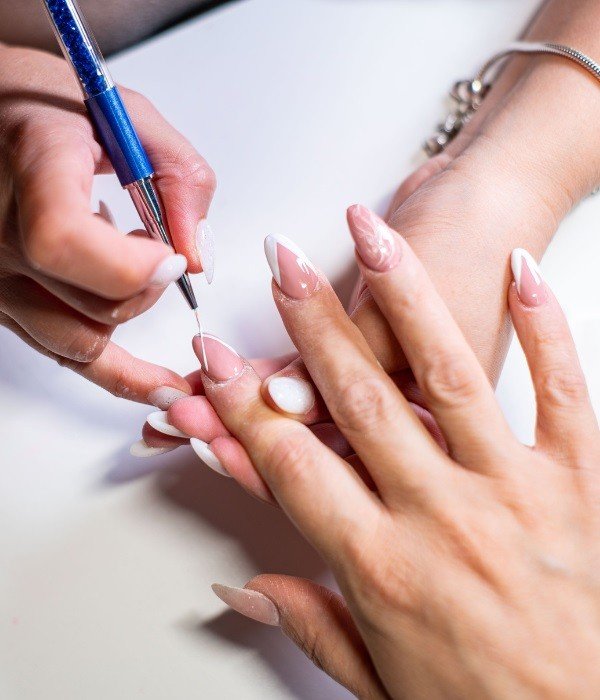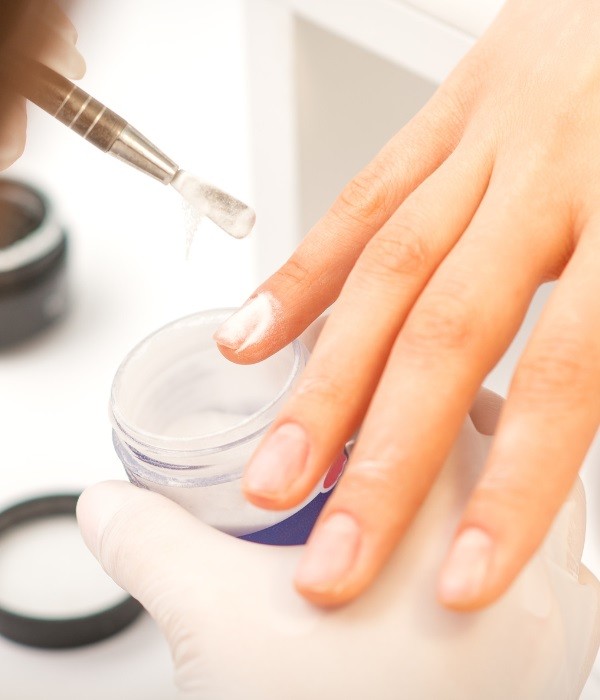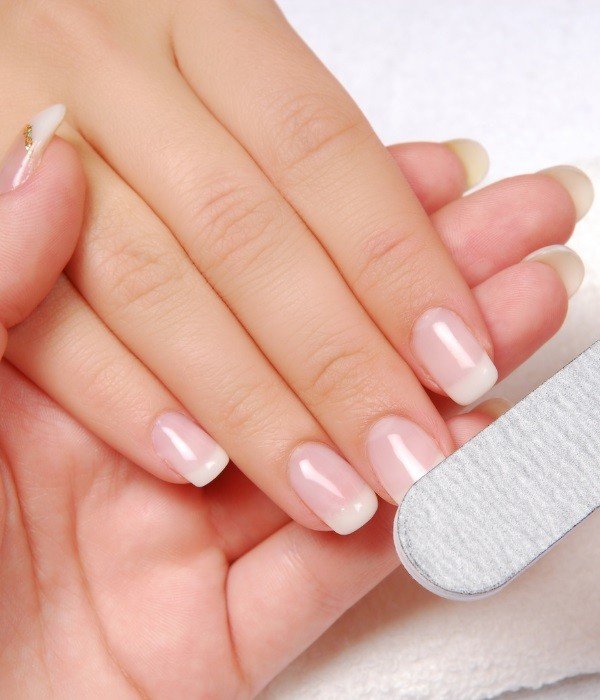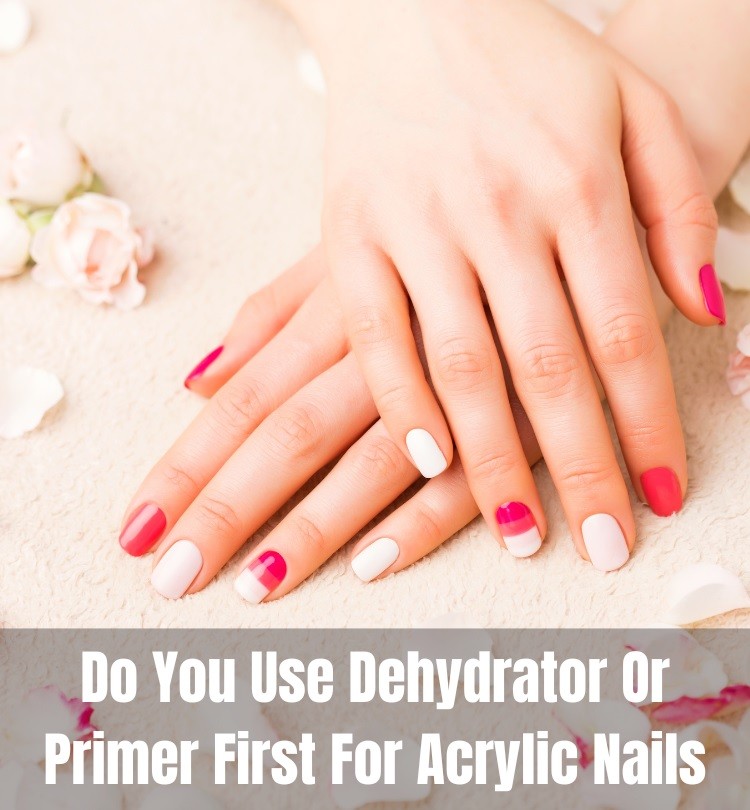This post contains affiliate links.
Updated on January 1, 2024
For acrylic nails, always use a dehydrator before applying a primer. A dehydrator removes moisture and oil from the nail plate, allowing for better adhesion of the acrylic.
On the other hand, a primer is applied after the dehydrator and helps the acrylic bond with the natural nail. By following this specific order, the acrylic nails will last longer and look more professional. It’s important to note that if the dehydrator is skipped, the primer may not adhere properly, leading to the lifting and chipping of the acrylic.
We’ll go over the benefits of using a dehydrator and primer for acrylic nails, as well as tips to ensure proper application for a flawless finish.
Contents
- The Basics Of Acrylic Nails
- Exploring The Role Of Dehydrator
- The Function Of Primer
- Which Comes First: Dehydrator Or Primer?
- Proper Application Techniques For Acrylic Nails
- Importance Of Proper Preparations For Acrylic Nails
- Frequently Asked Questions Of Do You Use a Dehydrator Or Primer First For Acrylic Nails?
- Conclusion
The Basics Of Acrylic Nails

Acrylic nails are artificial extension that is placed on top of natural nails to give them a better look. Acrylic nails are made of a liquid and a powder mixture that hardens to form a strong and durable nail.
Acrylic nails can be easily customized to an individual’s preference and come in different shapes, lengths, and designs. Here are the benefits of acrylic nails.
Related: Can You Use Face Primer As Eye Primer?
Definition And Benefits Of Acrylic Nails
Acrylic nails are popular among women who want to have long and beautiful nails without waiting for their natural nails to grow. Here are some benefits of acrylic nails:
- Customizable to preference
- Strong and durable
- Lasts longer than regular nail polish
- Can protect natural nails from breakage
The Role Of Dehydrator And Primer
Dehydrator and primer play a crucial role in applying acrylic nails. They are used before the application of acrylic to ensure that the nails are prepped and primed to get the best results. Here’s what you need to know about dehydrators and primers.
Dehydrator
A dehydrator is an essential step before applying acrylic nails. It removes all the oils, dirt, and moisture from natural nails, making sure that they are clean and dry. Here are some features of the dehydrator:
- Removes oils and moisture from nails
- Ensures better adhesion between natural nails and acrylic nails
- Can help prolong the lifespan of acrylic nails
Primer
Primer is used before applying acrylic nails to enhance adhesion and increase the lifespan of acrylic nails. It forms a bond between natural nails and acrylic nails, ensuring that they stick together. Here are some features of primer:
- Increases the lifespan of acrylic nails
- Helps the acrylic nails adhere to the natural nails
- Reduces the risk of infection by protecting the nail bed
Dehydrators and primers play a significant role in the application of acrylic nails. They ensure that the natural nails are prepped and primed, allowing for better adhesion and longer-lasting acrylic nails.
Exploring The Role Of Dehydrator

What Is Dehydrator And Its Importance In Nail Preparation
Nail dehydrators are the commonly used acidic solution for prepping natural nails before applying acrylics. They are essential to remove all-natural oils, dust, and debris from your nails, creating the perfect surface for smooth and flawless application. Using a dehydrator before a primer will not only help to achieve long-lasting acrylic nails but also prevent fungus attacks and lifting.
How Dehydrator Works And Its Benefits
- Dehydrators primarily work by breaking down the oils and moisture on your nails to expose a clean surface. The acidic solution opens up the nail matrix which helps the bonding process.
- Dehydrators are extremely effective for oily nail beds and those who have acrylic nails for an extended period. Without proper dehydration, the oils secreted by the nails can lead to lifting, cracking and infection.
- Dehydrators also help the nail art application process for those who have trouble with acrylic adhesion or natural oil production. Not only does it prevent polish lifting, but also protects the nail plate.
Steps On How To Use Dehydrator
- Clean your nails first and remove any existing polish or oils. You may use a cuticle pusher or nail file to remove the shine from the top surface, making sure to wipe off any dust with a lint-free nail wipe.
- Shake the dehydrator bottle well before use, and then apply a thin layer of the acidic solution with a brush to the full nails. Be sure to avoid it contacting the skin or cuticles.
- Wait for the dehydrator to dry completely before applying the primer to the nail surface. It will happen within 30 seconds to 1 minute, depending on the atmospheric temperature.
- Once done applying the primer, now apply the acrylic nails or any nail art of your choice. Note that dehydrators are a prepper that will aid you in achieving long-lasting and flawless skin.
By incorporating a dehydrator into your acrylic nails care routine, you can increase the durability of your polish, extend the time between your nail refills, and keep your nails healthy and strong.
Related: Can You Tan Through Concealer?
The Function Of Primer
Acrylic nails have become a staple for most women, especially those who have a busy schedule. Before applying acrylic, it’s important to ensure that your nails are prepared for the process. One of the essential steps in nail preparation is applying primer.
In this section, we’ll discuss the function of primer, the different types, and how to apply it.
Role Of Primer In Nail Preparation

Primer acts as a bonding agent between your natural nails and the acrylic. Its primary function is to dehydrate the nails to ensure that the acrylic adheres well and stays on for a longer time. It also protects your nails from fungus and bacteria.
Different Types Of Primers And Their Main Differences
There are different types of primers, and it’s crucial to choose the right one that suits your needs and reduces any allergic reaction. Here are the main differences between them:
- Acid-based primers: They contain methacrylic acid that reacts with the keratin in the nails to form a strong bond for the acrylic nails.
- Non-acid primers: They contain a combination of chemicals that don’t contain methacrylic acid. They’re suitable for people who are sensitive to acid and have a history of allergic reactions.
- Dehydrator: This preparation doesn’t contain acid, its function is to remove any moisture on the nails. It’s suitable for people with dry nails or those who prefer not to use acid-based primers.
Steps On How To Apply Primer
Now that you know the function of the primer and the different types let’s look at how to apply it.
- Firstly, clean and buff your nails with a nail file and cotton ball soaked in alcohol to remove any oil or dirt.
- Apply the primer of your choice to the nails and ensure that it doesn’t touch the skin to prevent irritation.
- Wait for the primer to dry before applying acrylic nails.
By following these simple steps, you’ll achieve perfect acrylic nails that last for weeks.
Remember to choose the appropriate primer that suits your needs and preferences. With a well-prepared nail bed, the acrylic will remain in place for longer and will look beautiful.
Which Comes First: Dehydrator Or Primer?
Common Misconceptions On Dehydrator And Primers
Myth: Dehydrator and primer are interchangeable.
Explanation: Dehydrator and primer are two different things that serve different purposes. Contrary to popular belief, they cannot be used as substitutes for each other.
Myth: Using both dehydrator and primer is a waste of time and money.
Explanation: Dehydrator and primer work together to create a strong bond between the natural nail and the acrylic. Skipping either step can compromise the durability of the acrylic nails.
The Correct Sequence Of Applying Dehydrator And Primer
Step 1: Clean the nails with soap and water.
Step 2: Apply dehydrator to the nails.
Explanation: The dehydrator removes moisture and oils from the natural nails, creating a dry surface for the primer to adhere to.
Step 3: Apply primer to the nails.
Explanation: Primer acts as a bonding agent between the natural nail and the acrylic. It also helps prevent the lifting and yellowing of the acrylic nails.
Step 4: Wait for the primer to dry completely before applying acrylic.
Remember, proper application of dehydrator and primer is crucial for creating durable and long-lasting acrylic nails. By following the correct sequence and steps, you can ensure that your acrylic nails look beautiful for weeks to come.
Factors To Consider When Choosing Dehydrators And Primers
Dehydrators and primers work by preparing the natural nail for the application of acrylic nails. It is essential to select the right products to ensure that the acrylic nails adhere to the natural nail securely. Here are some essential factors to consider when choosing dehydrators and primers:
- Quality of the product
- Safety of the user
- Strength of the adhesion to the natural nail
- Drying time
- Compatibility with other products
- Longevity of the application
Proper Application Techniques For Acrylic Nails
Tips For Preparing Your Nails For Acrylic Application
Before you start applying acrylic nails, it is crucial to prepare your nails properly. This step is often overlooked, but it is vital to ensure the longevity of your nail extensions. Here are some tips to prepare your nails for acrylic application:
- Start by shaping your nails with a file to your desired length and shape.
- Push back your cuticles using a cuticle stick and trim any excess skin.
- Buff the surface of your nails gently to remove the shine and roughen them up slightly. This will help the acrylic adhere better.
- Cleanse your nails thoroughly with acetone to remove any oils or residue from the nail bed.
Step-By-Step Guide On Applying Acrylic Nails
Once you have prepared your nails, it’s time to start applying the acrylic. Here is a step-by-step guide on how to apply acrylic nails:
- Apply a primer to the nails and let it dry for 30 seconds. This will help the acrylic adhere better.
- Cut a piece of nail extension form and stick it under the free edge of the natural nail.
- Apply a bead of acrylic to the brush and place it on the nail in the middle of the form, then push it down to the cuticle area.
- Use the brush to manipulate the acrylic into your desired shape. Work quickly but carefully, as acrylic dries fast.
- Repeat the previous steps on the other nails until you have completed them all.
- Wait for the acrylic to dry, then remove the extension form from each nail.
- Once the acrylic has dried completely, file and shape it to your desired look.
- Buff the acrylic to smooth out any rough edges.
Common Mistakes To Avoid When Applying Acrylic Nails
Applying acrylic nails can be challenging, especially if you are new to it. Here are some common mistakes to avoid when applying acrylic nails:
- Skipping the nail preparation step can lead to acrylic lifting off the nail bed and not lasting as long.
- Using too much primer can cause the acrylic to lift off or crack.
- Applying too thick of a bead of acrylic can cause cracking and breaking.
- Filing too much or too roughly can damage the natural nail bed.
- Neglecting to clean the brush properly can cause it to harden and ruin the brush.
With the proper application techniques, you can achieve a stunning and long-lasting look with acrylic nails. By following the above tips for preparing your nails, a step-by-step guide on applying acrylic nails, and avoiding common mistakes, you can master the art of acrylic application.
With patience and practice, your acrylic nails will become a work of art that you can show off to the world.
Related: Does Concealer Go On Before Or After Tinted Moisturizer?
Importance Of Proper Preparations For Acrylic Nails
Getting acrylic nails is an excellent way to enhance your appearance. The secret to having perfect acrylic nails is in preparation. Nail preparation requires attention to detail and the use of the right products. One of the common questions people ask is whether to use a dehydrator or primer first for acrylic nails.
This blog post explores the benefits of proper nail preparation for acrylic application, the risks of applying acrylics without proper preparations, and the benefits of using dehydrators and primers in nail preparations.
Benefits Of Proper Nail Preparation Before Acrylic Application
Proper nail preparation is vital before getting acrylic nails. Preparing the nails appropriately enhances the longevity and quality of the acrylic application. Here are some benefits of proper nail preparations:
- Removing the natural oils on your nails is important before applying acrylics. Dehydrating the nails ensures that the acrylic adheres well and makes it hard to pop off.
- Properly filing and buffing the nails helps the acrylic stick better by creating a rough surface, so it adheres tightly. Buffing also prevents the formation of air bubbles under the acrylic.
- Cleaning the nails thoroughly helps in preventing any bacteria and germs from getting trapped between the acrylic and natural nails.
- Cuticles should be pushed back or removed completely to prevent lifting and falling off of the acrylic nails.
- Properly prepping the nail bed ensures that there’s no lifting, cracking, or peeling of the acrylics.
Risks Of Applying Acrylics Without Proper Preparations
Skipping prepping your nails adequately before acrylic application may result in some serious problems:
- If the natural oils aren’t removed, the acrylic nails won’t adhere well.
- If you don’t clean your nails, bacteria and germs may penetrate under the acrylic and cause infections.
- Failure to file and buff the nails may result in the acrylic falling off, forming air bubbles, or lifting.
- If the cuticles aren’t pushed back, they may infect, resulting in unwanted hangnails.
Benefits Of Using Dehydrator And Primer In Nail Preparations
Using dehydrators and primers in nail preparation can enhance the strength and longevity of acrylic nails. Here are some benefits of using a dehydrator and primer:
- The dehydrator removes all the oils from the nail bed, increasing the adhesion of the acrylic.
- Dehydrator prevents any fungi- or bacteria-like substances from infecting your nail bed.
- Primer, applied after the dehydrator, helps acrylic adhere to the natural nails, preventing lifting, cracking, or peeling.
Understanding the importance of proper nail preparation before applying acrylics is crucial. Proper preparation ensures that the acrylics adhere well and last long. Always use a dehydrator and primer in your preparation for perfect, long-lasting acrylic nails.
Frequently Asked Questions Of Do You Use a Dehydrator Or Primer First For Acrylic Nails?
Can I Apply A Dehydrator And Primer Together?
It’s recommended to apply a dehydrator before the primer for better adhesion and longer wear time.
Do I Need To Use A Dehydrator For Acrylic Nails?
Using a dehydrator is important for acrylic nails as it removes oils and prepares for application.
Can I Skip The Dehydrator Step For Acrylic Nails?
Skipping the dehydrator step may cause lifting and the acrylic nails won’t last as long.
Is A Primer Necessary For Acrylic Nail Application?
Using a primer is necessary as it provides a stronger bond and helps prevent lifting.
Can I Apply The Primer First And Then Use the Dehydrator?
Applying the primer first and then using a dehydrator can cause the primer to not adhere properly. It’s best to follow the recommended order.
Conclusion
Proper application of acrylic nails requires a careful step-by-step procedure. While both dehydrator and primer serve essentially the same purpose of preparing the nail bed, the order in which they are used can make a difference in the longevity of the acrylic nails.
Dehydration helps to remove any moisture or natural oils from the nail bed that can interfere with acrylic adhesion. On the other hand, primer creates a stronger bond between the acrylic and the natural nail. While there is no definite rule on whether to use dehydrator or primer first for acrylic nails, it is generally safer to use them in the recommended order.
This not only ensures optimal bonding but also reduces the risk of any potential damage to the natural nail. Ultimately, the choice comes down to personal preference and the specific requirements of each individual’s nail bed. With the right approach, anyone can achieve long-lasting and beautiful acrylic nails.

